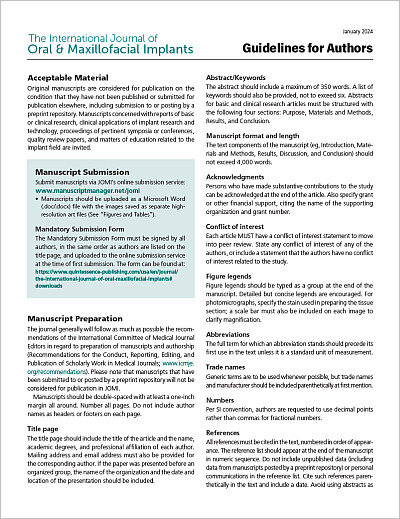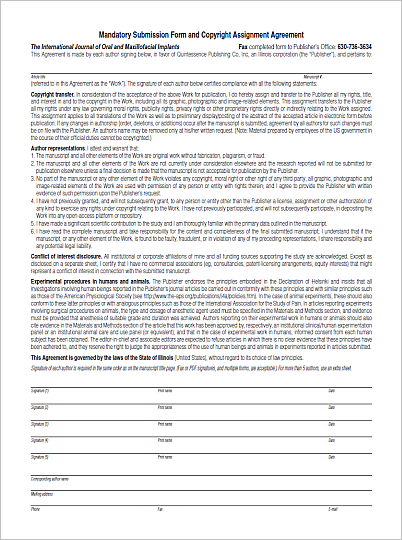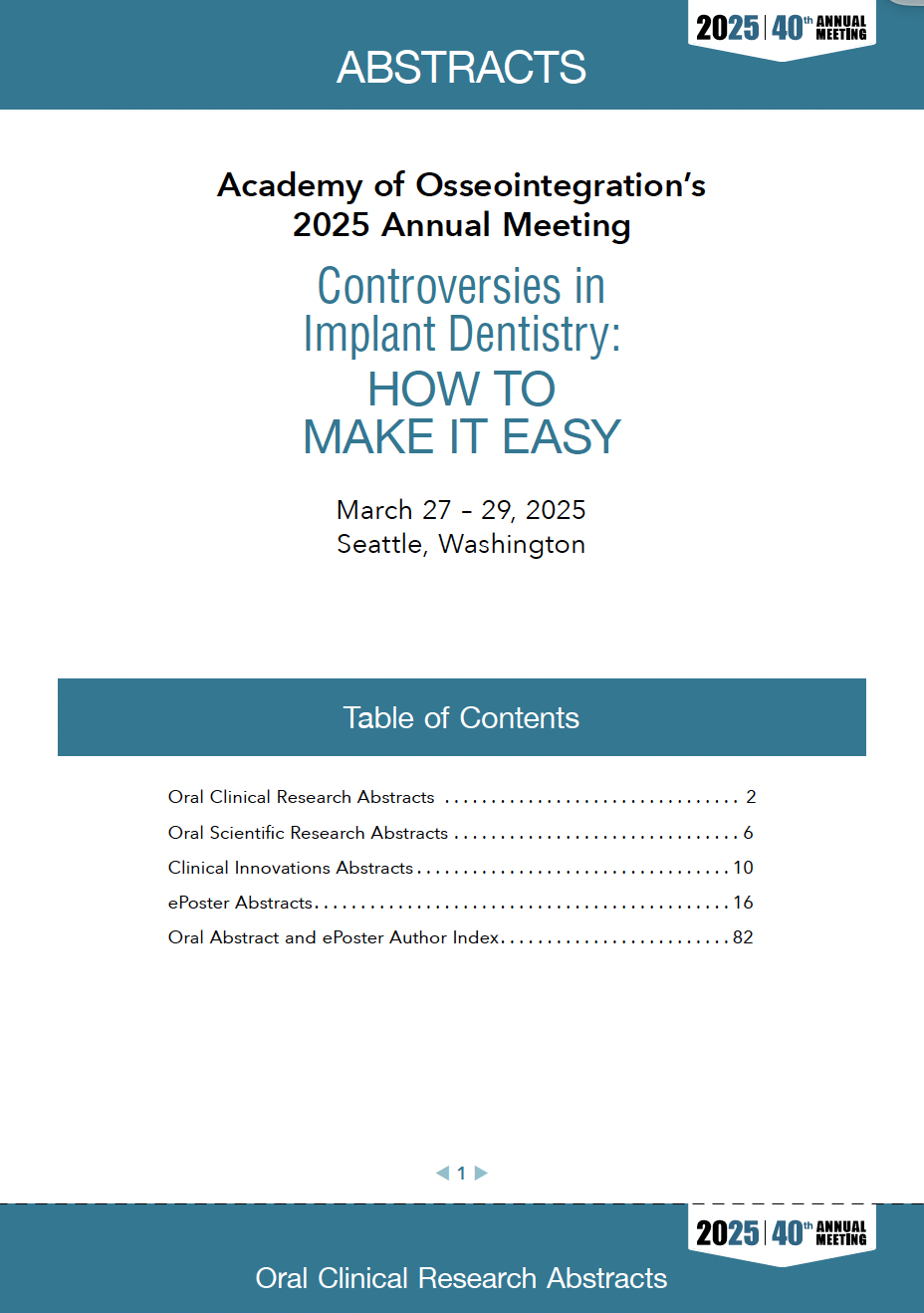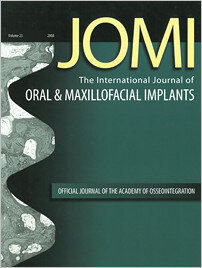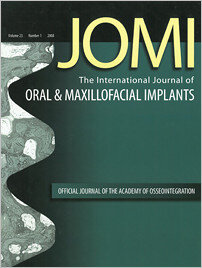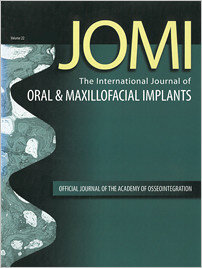PubMed ID (PMID): 19216267Pages 989, Language: EnglishEckert, Steven E.Pages 999-1002, Language: EnglishStanford, ClarkPubMed ID (PMID): 19216268Pages 1003-1012, Language: EnglishFontana, Filippo / Santoro, Franco / Maiorana, Carlo / Iezzi, Giovanna / Piattelli, Adriano / Simion, MassimoPurpose: To compare clinically and histologically an allogeneic bone matrix to autogenous bone chips in the vertical ridge augmentation technique using titanium-reinforced e-PTFE membranes.
Materials and Methods: The study protocol was designed to include patients with bilateral posterior mandibular partial edentulism. Patients were treated with a split-mouth design approach: each side was randomly assigned to the test group (titanium-reinforced e-PTFE membrane and allogeneic bone matrix) or to the control group (titanium-reinforced e-PTFE membrane and autogenous bone chips). Different clinical parameters including the amount of vertically regenerated bone (DSB) and biologic complications were recorded. Histomorphometric analysis and the bone-implant contact percentage were performed.
Results: Five female patients were enrolled in the study. Ten edentulous sites were vertically augmented and 25 implants were inserted (13 test group, 12 control group) with a staged approach. In the test group no membrane was exposed. The mean bone regeneration was 4.70 mm (SD 0.48 mm). All 13 implants appeared clinically stable. In the control group, 1 membrane was exposed after 2 months. The mean crestal bone regeneration was 4.10 mm (SD 0.88 mm). All 12 implants were stable at the abutment connection. Nine biopsy specimens from the regenerated areas were evaluated. Vertical bone regeneration was evident in both groups since all the samples demonstrated trabecular bone with different degrees of maturation and mineralization in the regenerated area.
Conclusion: Within the limits of this study based on 5 patients, it appears that the behavior of the allogeneic bone matrix is similar to that of autogenous bone chips when used for vertical ridge augmentation by means of guided bone regeneration techniques. Both grafts demonstrated analogous histologic characteristics. Nevertheless, long-term clinical studies are needed to confirm these preliminary results.
Keywords: allogeneic bone matrix, autogenous bone, barrier membranes, demineralized bone matrix, guided bone regeneration, osseointegration, vertical ridge augmentation
PubMed ID (PMID): 19216269Pages 1013-1019, Language: EnglishKodama, Takashi / Goto, Tetsuya / Miyazaki, Toshiki / Takahashi, TetsuPurpose: Bone morphogenetic proteins (BMPs) strongly induce osteogenesis and are enhanced by heparin. In this study, a potent osteoinductive material was developed by coating the surface of titanium with apatite incorporated with BMP and heparin.
Materials and Methods: Titanium samples were treated with a 5 N NaOH solution and heated at 600°C for 24 hours. The treated titanium was soaked in simulated body fluid (SBF) for 4 days and additionally soaked in SBF containing recombinant human BMP-2 (rhBMP-2;1,000 ng/mL) with or without heparin (30 µg/mL) for 3 days at 37°C. The surfaces of each sample were examined with scanning electron microscopy. The presence of rhBMP-2 on the surface of the apatite-coated titanium was examined using the immunogold method. MC3T3-E1 osteoblast-like cells were cultured on the surface of each sample. The number and morphology of the adherent cells, alkaline phosphatase activity, and osteocalcin mRNA expression were examined.
Results: Apatite was formed on the surface of alkaline heat-treated titanium after soaking in SBF for 7 days. The presence of rhBMP-2 was confirmed by the distribution of BMP-positive immunogold particles. The incorporation of (>= 3 µg/mL) heparin significantly increased alkaline phosphatase activity and osteocalcin mRNA expression in the cells on apatite-coated titanium containing rhBMP-2.
Conclusion: These findings demonstrate that heparin enhanced BMP-2-induced osteogenesis on apatite-coated titanium without the loss of BMP-2 activity. The combination of BMP-2 and heparin was effective even in the thin apatite layer formed on titanium using the alkaline heat treatment method.
Keywords: BMP-2, heparin, osteogenesis, simulated body fluid, titanium
PubMed ID (PMID): 19216270Pages 1020-1028, Language: EnglishYang, Guo-li / He, Fu-ming / Zhao, Shan-shan / Wang, Xiao-xiang / Zhao, Shi-fangPurpose: To investigate the effect of H2O2/HCl heat treatment on peri-implant bone formation in vivo.
Materials and Methods: Twenty Ti-6Al-4V implants and 30 Ti-6Al-4V discs were used in this study. The implants and discs were separated into 2 groups: sandblasted and dual acid-etched group (control group) and sandblasted, dual acid-etched and H2O2/HCl heat-treated group (test group). Surface morphology, roughness, and crystal structure of the discs were analyzed by field-emission scanning electron microscopy, atomic force microscopy, and low angle X-ray diffractometry. The implants were inserted into the femurs of 10 adult white rabbits. Animals were injected with fluorescent bone labels at 1, 5, and 7 weeks following surgery to monitor progress of bone formation. Animals were euthanized 8 weeks postsurgery, and block biopsies were prepared for histologic and histometric analysis.
Results: Microscopic evaluation showed the surfaces were quite irregular for both techniques; however, the test surface demonstrated consistently smaller surface irregularities. The differences in Sa values were significant (P = .022). No significant differences were found in the maximum peak-to-valley ratio values (P = .258). X-ray diffractometry analysis showed that titanium dioxide was found on the test surface. New bone was formed on both implant surfaces. The bone-implant contact pattern appeared to produce a broad-based direct contact. Test implants demonstrated 7.13% more bone to implant contact (P = .003) and 15.42% more bone to implant contact for 3 consecutive threads (P = .001) than control implants. Test implants demonstrated 37.04% more bone area 500 µm outside of implant threads (P = .004) and 51.97% more bone area within 3 consecutive threads (P = .001) than control implants. No significant differences were found in bone area within all implant threads between the two groups (P = .069).
Conclusion: This study demonstrated that implants heat-treated with H2O2/HCl solution enhanced peri-implant bone formation.
Keywords: H2O2/HCl heat treatment, osseointegration, surface morphology, surface roughness, titanium dioxide
PubMed ID (PMID): 19216271Pages 1029-1036, Language: EnglishKerstein, Robert B. / Radke, JohnPurpose: Studies have described the reliability of zirconia as an implant abutment material. The purpose of this in vitro study was to compare the precision and fracture strength of 2 different zirconia abutments angled at 30 degrees and loaded to failure in a standardized testing device.
Materials and Methods: Twenty-nine Atlantis abutments in zirconia (AAZ) and 29 Nobel Biocare Procera AllZirkon abutments of comparable interface were measured for key interface feature statistical differences (analysis of variance; a = 95%). Each specimen was fixed to a regular-platform Brånemark System implant and mounted in an Instron machine. Increasing incremental loads were applied until failure. A 2-tailed t test for independent specimens and unequal variances was employed (a = 95%). The Weibull method determined the probability of failure of each abutment sample (a = 95%). Fractography by scanning electron microscopy determined the flaws at the fracture origins.
Results: Metrology inspection indicated that the AAZ showed no measurable dimensional differences of 4 key interface features. The mean failure load of the AAZ (831 N) was greater than the AllZirkon (740 N; P .00006). The Weibull distribution showed that the AAZ would be more likely to survive intraoral occlusal loads (P .0005).
Conclusions: Both types of zirconia abutments demonstrated failure loads that exceed maximum human bite force. In vitro, the AAZ outperformed the AllZirkon in survivability. The clinical use of zirconia abutments is indicated when esthetics may be of concern.
Keywords: fractography, fracture strength, key interface features, metrology inspection, Weibull modulus
PubMed ID (PMID): 19216272Pages 1037-1046, Language: EnglishFerguson, Stephen J. / Langhoff, Jens D. / Voelter, Katrin / Rechenberg, Brigitte von / Scharnweber, Dieter / Bierbaum, Susanne / Schnabelrauch, Matthias / Kautz, Armin R. / Frauchiger, Vinzenz M. / Mu, Thomas L.Purpose: A satisfactory clinical outcome in dental implant treatment relies on primary stability for immediate load bearing. While the geometric design of an implant contributes to mechanical stability, the nature of the implant surface itself is also critically important. Biomechanical and microcomputerized tomographic evaluation of implant osseointegration was performed to compare alternative structural, chemical and biochemical, and/or pharmaceutical surface treatments applied to an identical established implant design.
Materials and Methods: Dental implants with the same geometry but with 6 different surface treatments were tested in vivo in a sheep model (pelvis). Peri-implant bone density and removal torque were compared at 2, 4, and 8 weeks after implantation. Implant surfaces tested were: sandblasted and acid-etched titanium (Ti), sandblasted and etched zirconia, Ti coated with calcium phosphate (CaP), Ti modified via anodic plasma-chemical treatment (APC), bisphosphonate-coated Ti (Ti + Bisphos), and Ti coated with collagen containing chondroitin sulfate (CS).
Results: All dental implants were well integrated at the time of sacrifice. There were no significant differences observed in peri-implant bone density between implant groups. After 8 weeks of healing, removal torque values for Ti, Ti + CaP, Ti + Bisphos, and Ti + collagen + CS were significantly higher than those for zirconia and Ti + APC.
Conclusions: Whereas the sandblasted/acid-etched Ti implant can still be considered the reference standard surface for dental implants, functional surface modifications such as bisphosphonate or collagen coating seem to enhance early peri-implant bone formation and should be studied further.
Keywords: biomechanics, bisphosphonate, collagen, dental implant, osseointegration
PubMed ID (PMID): 19216273Pages 1047-1052, Language: EnglishElla, Bruno / Sédarat, Cyril / Noble, Reynald Da Costa / Normand, Eric / Lauverjat, Yves / Siberchicot, François / Caix, Philippe / Zwetyenga, NarcissePurpose: There are several vascular vessels that supply the maxillary sinus, such as the posterior superior alveolar artery, the anterior superior alveolar artery, and the infraorbital artery (IOA). These vessels have to be taken into consideration during a sinus augmentation because of the potential risk of bleeding during the procedure. The objective of this investigation was to study variations in maxillary sinus artery connections with the potential surgical effect during a sinus floor elevation by the lateral wall. Materials and Methods: The first part of the study was done in 32 anatomical specimens embedded in 10% formaldehyde solution and aged between 55 and 70 years (mean, 61.3 years). The second part of the study was a radiographic study using computerized tomographic (CT) scan images in 35 randomized patients treated in odontology and maxillofacial surgery departments. Results: Results were recorded for 134 sinuses. In most cases, there was no vessel visible or no vessel present with a diameter less than 0.5 mm after dissection or CT-scan analysis: 120 sinuses (89.5%). In 14 cases (10.5%) there were vessels in the lower two thirds of the anterolateral wall. In 10 sinuses (71.4% of the 14 cases), there was an intraosseous or intrawall artery and in 2 sinuses (14.3%) they were in the intrasinusal position. In 8 of the 14 sinuses (57.1%, about 6% of overall sinuses) the diameter was between 1 and 2.5 mm. Conclusion: Knowledge of the arterial supply is essential for surgical treatment in the sinus area. A CT scan is recommended and the radiologist must be advised to search for intraosseous or extraosseous vessels in the lower two thirds of the maxillary sinus.
Keywords: maxillary sinus, sinus augmentation, vascular vessels
PubMed ID (PMID): 19216274Pages 1053-1062, Language: EnglishArisan, Volkan / Özdemir, Tayfun / Anil, Ata / Jansen, John A. / Özer, KürsatPurpose: Peri-implant dehiscence defects occur frequently after dental implant placement. Various graft materials and techniques are proposed for treatment. In this study, an injectable calcium phosphate cement (Augmentech, Wetzlar, Germany) applied to a peri-implant defect was investigated.
Materials and Methods: Standardized buccal dehiscence defects (5.8 x 3.8 mm) were surgically created after implant site preparation in the right proximal tibiae of 5 beagle dogs. Fifteen stepped cylindrical implants (13 x 3.8 mm diameter) were inserted (3 per dog), and Augmentech injectable calcium phosphate cement was injected into the dehiscences. The bone at the distal side of the implant was left intact to serve as a control. Postsurgically, each dog received double staining of 2 fluorescent labels for estimation of bone cell activity at baseline and after 11 weeks of healing. The animals were sacrificed after 12 weeks. Dissected blocks were processed for histologic, histomorphometric, and fluorescence microscopic analysis, ie, percentage of bone-to-implant contact (BIC) and percentage linear bone height (LBH) were measured. Student t and Mann Whitney U tests were used for statistical analysis (P .05).
Results: Healing was uneventful in all dogs. Augmentech injectable calcium phosphate cement showed good space maintenance and osteoconductive properties with no foreign body reaction. BIC was 34.42 (± 19.88) and 37.00 (± 21.33) (P = .375), while LBH was 84.23 (± 19.73) and 96.10 (± 6.66) (P = .125) for test and control sites, respectively.
Conclusion: Within the limits of the present study, it was concluded that Augmentech injectable calcium phosphate cement may be a suitable material for the treatment of buccal dehiscence defects around dental implants.
Keywords: calcium phosphate, dehiscence, dental implant, dog study, grafting
PubMed ID (PMID): 19216275Pages 1063-1070, Language: EnglishArtzi, Zvi / Kozlovsky, Avital / Nemcovsky, Carlos E. / Moses, Ofer / Tal, Haim / Rohrer, Michael D. / Prasad, Hari S. / Weinreb, MironPurpose: The objective of this study was to histomorphometrically evaluate the synthetic peptide analog P-15 bound to anorganic bovine mineral (Pepgen/P15) in critical-size defects in the rat calvaria.
Materials and Methods: A 5-mm-diameter critical-size defect was prepared in 48 rat skulls and divided into 4 equal groups: Pepgen/P15 particles covered by a membrane, Pepgen/P15 particles uncovered, nongrafted membrane-protected sites, and nongrafted uncovered control sites. At 12 weeks, histomorphometric measurements were made of the percentage area of newly formed bone and residual particles, the length of internal and external bone bridging, and linearly, the regenerated marginal and central total tissue augmentation height.
Results: Nongrafted, membrane-protected sites gained 60.6% of newly formed bone, followed by 50.6% and 44.2% (P .05 versus membrane only) at the grafted covered and uncovered sites, respectively. All experimental sites contained significantly (P .005) more bone than did control sites (19.9%). In both types of grafted sites, the percentage area of Pepgen/P15 particles was similar. Mean internal and external length of bone bridging at nongrafted membrane-protected sites (76.7% and 71.2%, respectively) was significantly greater (P .005) than that of the grafted covered (43.95% and 51.8%, respectively), grafted uncovered (28.7% and 23.9%, respectively), and control (28% and 25.5%, respectively) groups, except for internal bone bridging in the grafted covered sites. Regenerated marginal and central augmentation heights (0.92 mm and 1.02 mm, respectively) were greatest in the grafted covered group, followed by the nongrafted membrane-protected (0.88 mm and 0.51 mm, respectively), and grafted uncovered (0.89 mm and 0.12 mm, respectively) groups, all of which were significantly greater (P .001) than the control group (0.63 mm and 0.04 mm, respectively).
Conclusion: While anorganic bovine mineral/cell-binding peptide contributes in volume, membrane application significantly increases the amount of bone regeneration.
Keywords: bovine bone mineral, cell-binding peptide, critical-size defect, guided bone regeneration, histomorphometry, PepGen/P-15
PubMed ID (PMID): 19216276Pages 1071-1081, Language: EnglishArpornmaeklong, Premijt / Akarawatcharangura, Butsakorn / Pripatnanont, PrisanaPurpose: To investigate the influence of exposure time and stages of cell growth on the effects of specific COX-2 inhibitor NSAIDs on growth and differentiation of osteoblasts on smooth titanium surfaces. Materials and Methods: The study was categorized into 5 groups: group A, 0.1 µM indomethacin; group B, 1.5 µM celecoxib; group C, 3.0 µM celecoxib; group D, 9.0 µM celecoxib; and group E, serum-free culture medium without drug treatment. A mouse calvarial cell line, MC3T3-E1, was seeded on acid-prickled surface titanium disks. The investigations were performed in 3 experimental phases based on stages of cell growth: static (24 hours after seeding), log (culture day 5), and plateau (culture day 12). In each experimental phase, cells on titanium disks were incubated in a medium treated with drugs according to the groups of study for 1, 3, and 5 days. Results: Indomethacin and celecoxib in groups A to D inhibited growth of cells on treatment days 3 and 5 in static phase and on treatment day 3 in log phase. Additionally, an inhibitory effect of indomethacin was greater than celecoxib. Effects on alkaline phosphatase (ALP) activity and osteocalcin were not clearly demonstrated. A significant decrease of PGE2 production was found in groups A to D in static and plateau but not log phases. Conclusion: A specific COX-2 inhibitor NSAID, celecoxib, inhibited growth of osteoblasts on titanium surfaces and the effects were influenced by exposure time and stages of cell growth. Using a specific COX-2 inhibitor might cause deterioration of osteointegration of dental implants by interfering with osteoblastic cell growth in the proliferative stage.
Keywords: growth and differentiation, osteoblasts, specific COX-2 inhibitor NSAIDs, titanium surface
PubMed ID (PMID): 19216277Pages 1082-1088, Language: EnglishDeng, Bin / Tan, Keson B. / Liu, Gui Rong / Lu, YiPurpose: Resonance frequency analysis (RFA) has been widely used to predict dental implant stability by assessing conditions surrounding the implant. The aim of this study was to investigate the influence of osseointegration degree and pattern on the resonance frequency of implant-bone structure by means of finite element analysis (FEA).
Materials and Methods: A basic FEA model was created to represent a titanium implant in a portion of the maxillary bone at the left first premolar region. This model was then used to compute the vibration behaviors for 5 osseointegration degrees and 8 osseointegration pattern models using modal and harmonic analysis.
Results: In the arbitrarily set osseointegration pattern models, a significant influence of osseointegration degree on the resonance frequency (P .001) could be expressed as the linear function R2 = 0.99. No significant influence from the osseointegration pattern could be observed (P = .89). While the coronal-osseointegration model had a slightly higher resonance frequency than others and the apical-osseointegration model had the lowest, the difference between the highest and lowest value was within 5% (P = .51). In the randomly set osseointegration models, the osseointegration degree had a statistically significant influence on the resonance frequency (P .001); the pattern of random osseointegration for a certain osseointegration degree had little influence.
Conclusion: It seems that RFA can detect implant-stability changes related to the increase in osseointegration degree. However, careful consideration should be given to its use in predicting the stability in vivo of loss of osseointegration at the marginal bone.
Keywords: finite element analysis, implant stability, osseointegration, resonance frequency analysis
PubMed ID (PMID): 19216278Pages 1089-1094, Language: EnglishLee, Sang-Hwa / Yoon, Hyun-Joong / Park, Min-Kyu / Kim, You-SungPurpose: This study aimed to measure the numbers of viable bone cells present in autogenous drilling dust (ADD) and mandibular particulated bone (MPB) and to histomorphometrically compare the effects of the combined use of resorbable membranes and ADD or xenografts for the treatment of dehiscence-type defects around implants.
Materials and Methods: The left mandibular premolars were extracted from 4 adult beagle dogs. After a 3-month healing period, 4 standardized bone defects were prepared on each mandible, and 1 implant was placed per defect. The 4 sites in each dog were allocated to 4 different treatment groups: 1 site received ADD alone (ADD); 1 site received a Cytoplast membrane supported by ADD (ADD+CP); 1 site received BioCera alone (BC); and the final site received a Cytoplast membrane supported by BioCera (BC+CP). Each animal received a series of 3 bone labels. Three months following these regenerative surgeries, animals were sacrificed and histomorphometric examinations were carried out. In addition, in 3 of the 4 dogs at the time of regenerative surgery, ADD was obtained using implant drills (group 1), MPB was obtained using a fissure bur and rongeur (group 2), and 1.0 cm3 of each was then cultured. Cultured cell counts and osteocalcin synthesis analysis using reverse transcription-polymerase chain reaction were performed on cells from these 2 groups at 4 and 9 weeks after regenerative surgery. Alkaline phosphatase activity (ALP) was measured at 9 weeks in both groups.
Results: MPB revealed greater cell counts than ADD after 4 and 9 weeks. Cells stained positively for ALP and osteocalcin in both groups. Fluorescence microscopy showed 22.4% bone formation with ADD+CP, 17.8% with BC+CP, 13.1% with ADD, and 6.4% with BC at 8 weeks. Bone regeneration heights were 2.0 mm with AD, 1.9 mm with ADD+CP, 1.7 mm with BC+CP, and 1.3 mm with BC. Bone regeneration areas measured 1.0 mm2 with ADD, 0.9 mm2 with ADD+CP, 0.6 mm2 with BC+CP, and 0.3 mm2 with BC. Bone-to-implant contacts were 53.1% with ADD, 46.6% with ADD+CP, 44.1% with BC, and 33.7% with BC+CP.
Conclusions: ADD appears to be a useful material for closing dehiscence-type defects, and the use of a membrane was not found to affect bone formation during the treatment of dehiscence-type defects around implants in this study. However, larger studies are needed before fully endorsing its widespread use.
Keywords: alkaline phosphatase, autogenous drilling dust, dehiscence, osteocalcin
PubMed ID (PMID): 19216279Pages 1095-1101, Language: EnglishOhkubo, Chikahiro / Kobayashi, Mariko / Suzuki, Yasunori / Hosoi, ToshioPurpose: The use of a limited number of implants for support of a removable partial denture (RPD) changes a Kennedy Class I or II situation to that of a Class III. This in vivo pilot study evaluated implant-supported distal-extension removable partial dentures (RPD) in 5 partially edentulous patients.
Materials and Methods: Two implants (Brånemark TU MK III, Nobel Biocare) were placed in a mandibular Kennedy Class I arch. To fabricate an implant-supported RPD (ISRPD), a conventional RPD base was fitted to the healing abutment with autopolymerizing acrylic resin (Uni-fast II, GC) to support the posterior aspect of the RPD. By changing the healing abutment to a healing cap, there was no connection between the denture base and implant, and the ISRPD became a conventional RPD (CRPD). Using a crossover study design, the masticatory movements (mandibular movements during mastication) of both dentures were measured using a commercially available tracking device (BioPACK, Bioresearch, Japan). The occlusal force and contact area were also measured using pressure-sensitive sheets and an image scanner (T-scan system). Using a visual analog scale (VAS), the 4 criteria of comfort, chewing, retention, and stability were evaluated. All the data obtained were analyzed using Wilcoxen signed rank tests (a = .05).
Results: There were no significant differences (P > .05) in masticatory movements between the ISRPD and the CRPD (5 patients: 4 women, 1 man). However, the ISRPD had significantly greater force and greater area than the CRPD (P = .043). The center of occlusal force of the ISRPD tended to move more distally compared to the CRPD. All the patients preferred the ISRPD for comfort, chewing, retention, and stability.
Conclusions: One implant per edentulous area and a simple attachment technique yielded a stable distal extension RPD.
Keywords: implant-supported removable partial dentures, masticatory movements, occlusal force, visual analog scale
PubMed ID (PMID): 19216280Pages 1102-1108, Language: EnglishBlake, Felix / Bubenheim, Michael / Heiland, Max / Pohlenz, Philipp / Schmelzle, Rainer / Gbara, AliPurpose: To investigate the susceptibility of implants to inflammation following autogenous bone transplantation and to evaluate whether various factors affect outcomes.
Materials and Methods: This retrospective cross-sectional clinical investigation involved patients who were treated between the years 1994 and 1996. The donor site, mode of transplantation, primary disease, gender, smoking habits, and age were evaluated with respect to outcomes. Clinical and radiologic assessments were the basis for the classification into 3 categories: (1) no inflammation, (2) mucositis, and (3) peri-implantitis. Lost implants were also noted. The data were evaluated statistically to determine whether significant differences existed.
Results: Forty-three patients (23 men and 20 women) were involved in this retrospective study. These patients received a total of 216 oral implants over a follow-up time of 8 to 10 years. Depending on the type of reconstruction, rates of peri-implant inflammation between 9% and 38% were observed. For mucositis, rates of 16.3% to 24.1% were seen, and 30% to 70.9% of sites showed no inflammation.
Conclusion: High rates of soft tissue inflammation adjacent to implants were observed. The choice of donor site in conjunction with the mode of transplantation seemed to influence the development of peri-implant inflammation. The microsurgically reanastomosed fibula seemed most resistant to inflammatory processes, followed by the microsurgically reanastomosed iliac crest, free iliac crest, and free fibula. No significant differences could be observed for primary disease. These findings should be taken into consideration prior to surgery and when establishing individual recall systems.
Keywords: free bone transplantation, jaw reconstruction, microsurgical transplantation, oral implants, peri-implantitis
PubMed ID (PMID): 19216281Pages 1109-1116, Language: EnglishBornstein, Michael M. / Halbritter, Sandro / Harnisch, Hendrik / Weber, Hans-Peter / Buser, DanielPurpose: This retrospective study analyzed the pool of patients referred for treatment with dental implants over a 3-year period in a referral specialty clinic.
Materials and Methods: All patients receiving dental implants between 2002 and 2004 in the Department of Oral Surgery and Stomatology, University of Bern, were included in this retrospective study. Patients were analyzed according to age, gender, indications for implant therapy, location of implants, and type and length of implants placed. A cumulative logistic regression analysis was performed to identify and analyze potential risk factors for complications or failures.
Results: A total of 1,206 patients received 1,817 dental implants. The group comprised 573 men and 633 women with a mean age of 55.2 years. Almost 60% of patients were age 50 or older. The most frequent indication for implant therapy was single-tooth replacement in the maxilla (522 implants or 28.7%). A total of 726 implants (40%) were inserted in the esthetically demanding region of the anterior maxilla. For 939 implants (51.7%), additional bone-augmentation procedures were required. Of these, ridge augmentation with guided bone regeneration was performed more frequently than sinus grafting. Thirteen complications leading to early failures were recorded, resulting in an early failure rate of 0.7%. The regression analysis failed to identify statistically significant failure etiologies for the variables assessed.
Conclusions: From this study it can be concluded that patients referred to a specialty clinic for implant placement were more likely to be partially edentulous and over 50 years old. Single-tooth replacement was the most frequent indication (> 50%). Similarly, additional bone augmentation was indicated in more than 50% of cases. Adhering to strict patient selection criteria and a standardized surgical protocol, an early failure rate of 0.7% was experienced in this study population.
Keywords: dental implants, early failure, guided bone regeneration, indications, sinus grafting procedures
PubMed ID (PMID): 19216282Pages 1117-1122, Language: EnglishBalshe, Ayman A. / Eckert, Steven E. / Koka, Sreenivas / Assad, Daniel A. / Weaver, Amy L.Purpose: To compare the long-term survival rates of smooth- and rough-surface dental implants among smokers and nonsmokers.
Materials and Methods: A retrospective chart review was conducted for 2 time periods: January 1, 1991, through December 31, 1996, during which smooth-surface implants were utilized, and January 1, 2001, through December 31, 2005, during which roughsurface implants were utilized. This review included all implants placed and restored in 1 institution during the 2 timeframes. Data were specifically collected relative to patient age, gender, smoking status, implant diameter, implant length, and anatomic location of implants. Implants from the first and second time periods were followed through mid-1998 and mid-2007, respectively. Associations of patient/implant characteristics with implant survival were evaluated using marginal Cox proportional hazards models (adjusted for age and gender) and summarized with hazard ratios (HR) and corresponding 95% confidence intervals (CI).
Results: A total of 593 patients (322 [54.3%] female; mean [SD] age, 51.3 [18.5] years) received 2,182 smooth-surface implants between 1991 and 1996, while 905 patients (539 [59.6%)] female; mean [SD] age, 48.2 [17.8] years) received 2,425 rough-surface implants between 2001 and 2005. Among the rough-surface implants, smoking was not identified as significantly associated with implant failure (HR = 0.8; 95% CI = 0.3 to 2.1; P = .68). In contrast, smoking was associated with implant failure among the group with smooth-surface implants (HR = 3.1; 95% CI = 1.6 to 5.9; P .001). Implant anatomic location was not associated with implant survival among patients with rough-surface implants (P = .45) and among nonsmokers with smooth-surface implants (P = .17). However, anatomic location affected the implant survival among smokers with smooth-surface implants (P = .004). In particular, implant survival was the poorest for implants placed in the maxillary posterior areas of smokers.
Conclusions: Based on this retrospective study, the following observations were made: Smoking was identified as a risk factor for implant failure of smooth-surface implants only; among the smokers who received smooth-surface implants, an association was identified between implant failure and location of the implant placement; no association was identified between implant failure and location among the smokers who received rough-surface implants.
Keywords: dental implants, rough surface implants, smooth surface implants, survival rates
PubMed ID (PMID): 19216283Pages 1123-1127, Language: EnglishElian, Nicolas / Jalbout, Ziad N. / Classi, Anthony J. / Wexler, Alon / Sarment, David P. / Tarnow, Dennis P.Purpose: To demonstrate the predictability of flapless surgery using navigation surgery.
Materials and Methods: Computer-generated preoperative implant planning was compared to actual placement by CT (computerized tomography) scanning of patients before and after surgery. Once pre- and postoperative coordinates of virtual implants were obtained, linear distances and angles were calculated. Coronal and apical errors consisted of the shortest distance from the preoperative planning to the postoperative overlay.
Results: Fourteen implants were placed in 6 patients who received CT scans before and after implant placement. Preoperative implant planning using software was compared to actual placement. The average discrepancy of the head of the implant was 0.89 mm ± 0.53 SD (range, 0.32 to 1.96). The average discrepancy of the apex of the implant was 0.96 mm ± 0.50 SD (range, 0.25 to 1.99). The average angle discrepancy and standard deviation were 3.78 degrees ± 2.76 SD (range, 0.60 to 9.87).
Conclusion: Optical computerized navigation is vulnerable to technological and technical errors. Yet, the present case series suggests that less than 1 mm of mean linear deviation and less than 4 degrees of angular deviation might be attainable.
Keywords: computerized tomography, computer-aided diagnosis, dental implants, flapless surgery, implant placement, surgical navigation
PubMed ID (PMID): 19216284Pages 1128-1132, Language: EnglishAimetti, Mario / Massei, Giampiero / Morra, Matteo / Cardesi, Enrico / Romano, FedericaPurpose: The most common complication during sinus graft surgery is tearing or perforation of the Schneiderian membrane. Perforations are most likely to occur if the sinus membrane is thin. Preoperative prediction of the antral membrane thickness may be of practical importance during maxillary sinus augmentation procedures. The purpose of this investigation was to analyze a possible association between gingival phenotypes and thickness of the healthy sinus mucosa.
Materials and Methods: Twenty consecutive patients without preoperative anamnestic, clinical, or radiologic signs of maxillary sinus pathologies were enrolled in the study. During otorhinolaringologic surgical interventions, maxillary mucosal biopsy specimens were endoscopically obtained from the sinus floor, and gingival thickness was measured at the maxillary anterior teeth.
Results: Eleven out of 20 individuals had thick gingival tissues, and the remaining 9 presented with thin gingival phenotype. The average thickness of the Schneiderian membrane was 0.97 ± 0.36 mm with a wide inter-individual variability. Thickness of the sinus mucosa amounted to 1.26 ± 0.14 mm in individuals with thick gingival architecture and 0.61 ± 0.15 mm in subjects with thin gingival tissues. The association between thickness of the antral mucosa and periodontal phenotypes was statistically significant (P .0001).
Conclusions: Gingival thickness seems to represent a reliable parameter to predict sinus membrane thickness. Further investigations are needed to support these preliminary data.
Keywords: gingival phenotypes, human histology, maxillary sinus, Schneiderian membrane, sinus mucosal thickness
PubMed ID (PMID): 19216285Pages 1133-1138, Language: EnglishAhn, Jae-Jin / Shin, Hong-InPurpose: To investigate postextraction bone formation over time in both diseased and healthy sockets.
Materials and Methods: Core specimens of healing tissues following tooth extraction were obtained at the time of implant placement in patients treated between October 2005 and December 2007. A disease group and a control group were classified according to socket examination at the time of extraction. The biopsy specimens were analyzed histomorphometrically to measure the dimensional changes among 3 tissue types: epithelial layer, connective tissue area, and new bone tissue area.
Results: Fifty-five specimens from sites of previously advanced periodontal disease from 45 patients were included in the disease group. Another 12 specimens of previously healthy extraction sockets were collected from 12 different patients as a control. The postextraction period of the disease group varied from 2 to 42 weeks. In the disease group, connective tissue occupied most of the socket during the first 4 weeks. New bone area progressively replaced the connective tissue area after the first 4 weeks. The area proportion of new bone tissue exceeded that of connective tissue by 14 weeks. After 20 weeks, most extraction sockets in the disease group demonstrated continuous new bone formation. The control group exhibited almost complete socket healing after 10 weeks, with no more new bone formation after 20 weeks.
Conclusions: Osseous regeneration in the diseased sockets developed more slowly than in the disease-free sockets. After 16 weeks, new bone area exceeded 50% of the total newly regenerated tissue in the sockets with severe periodontal destruction. In the control group, after 8 weeks, new bone area exceeded 50% of the total tissue.
Keywords: advanced periodontal disease, bone formation, coronal corticalization, extraction socket healing, timing of implantation
PubMed ID (PMID): 19216286Pages 1139-1142, Language: EnglishKim, Young-Kyun / Hwang, Jung-Won / Yun, Pil-YoungAlthough the sinus lift procedure is relatively safe, it does pose some potential problems. The most prevalent intraoperative complication is perforation of sinus membrane. Various techniques and materials have been developed for the repair of the perforated sinus membrane. In this case, pedicled buccal fat pad (BFP) was used for the closure of the large perforation on the sinus membrane and dental implants were placed simultaneously. No serious infections have occurred, and clinical and radiographic findings at the 1-year follow-up were adequate.
Keywords: buccal fat pad, dental implant, sinus lift
PubMed ID (PMID): 19216287Pages 1143-1146, Language: EnglishYamashita, Yoshio / Yamaguchi, Yoshimasa / Tsuji, Mitsuhiro / Shigematsu, Masahito / Goto, MasaakiSegmental mandibulectomy is a treatment option for benign and malignant neoplasms of the mandible. Although reconstructing the mandible of a patient with a missing segment is difficult, it is essential to improve the postoperative course of the patient. Mandibular reconstruction using titanium mesh is a useful technique for dental implant placement because the morphology of the mandible can be easily reproduced. However, fitting titanium mesh to the remaining mandible is not an easy task during surgery. The present report introduces a method in which a 3-dimensional skull model fabricated by means of stereolithography is prepared, based on computerized tomography (CT) scans, to construct a titanium mesh cage matching the shape of the mandible, preoperatively. Furthermore, the load-bearing area of the titanium mesh cage is reinforced by laser welding another layer of titanium mesh to reduce the incidence of metal fatigue during jaw movement.
Keywords: dental implant, iliac bone graft, laser welding, mandibular reconstruction, titanium mesh




